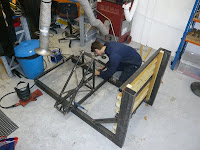
I have continued to update the Webots simulation model, including setting the correct joint torques and weight for leg components and body. I thought it would also be good to simulate the ball joint foot at the bottom of the metatarsus.
I have this all running now, including contact sensors which are fed back to the HexEngin via a TCP packet, so that terrain adaptation can be simulated. This worked surprisingly well, until I added the ball joint linkage, it seems to have slowed the simulation down to running at 0.2 x real time. This causes problems with contact feedback to the HexEngine, and the hexapod gets into an oscillating shuffle! I have experienced this in real machines before.. and its usually to do with contact sensor problems or leg speed tuning.
I can remove the ball joint at the end of the metatarsus, but its a bit of a shame, as I wanted to use the angle of the joint to simulate ankle joint position errors. I will post on the Webots forum to see if there is a solution, without purchasing a faster machine ( Currently dual Xeon 2.66Ghz, 4Gb )

The sinking issue: Having made the robot the correct weight, approximately 1600Kg, it now sinks into the floor by about 100mm. II have tweaked various settings in the simulator, including making the feet cubes instead of cylinders which apparently helps, however, this is apparently a feature of the physics engine, so I will have to put up with it, or reduce the weight of the machine for the simulation.
One encouraging point is that the machine was able to stand up at full weight :) which confirms our previous calculations and power requirements. We are aiming for a body weight of approximately 800Kg, the simulation seemed happy with a weight of 1200kg.
 The load pin has arrived, so we will also look at fitting this upon our return. I have yet to decide how I am going to wire this in to the HexEngine, I think I will need to modify the FACU box to take auxiliary analogue inputs, or create a new box that will also sit on the 485 bus which will act as an analogue/digital I/O module.
The load pin has arrived, so we will also look at fitting this upon our return. I have yet to decide how I am going to wire this in to the HexEngine, I think I will need to modify the FACU box to take auxiliary analogue inputs, or create a new box that will also sit on the 485 bus which will act as an analogue/digital I/O module.















































